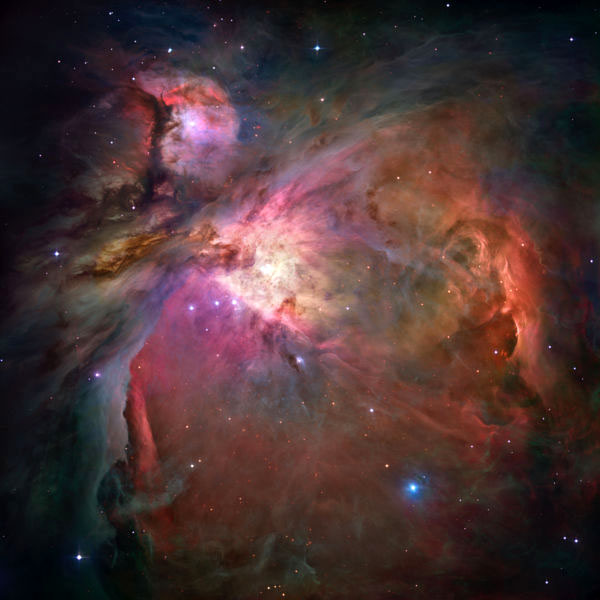
The Orion Nebula, catalogued as M42, is one of the closest and most studied star-forming regions. Located about 1,350 ly away, it provides a natural laboratory for studying gravitational collapse, ionization processes, and stellar wind-interstellar medium interactions.
Distance: \(d \approx 1,350\ \text{ly}\). Characteristic radius of the visible nebula: \(R \sim 12\ \text{ly}\) (order of magnitude depending on the optical contrast used). The nebula contains regions with strongly varying densities, from low-density ionized zones to dense globules where proto-stars are born.
Typical densities: in the ionized region (H II region) \(n \sim 10^{2}\) to \(10^{4}\ \mathrm{cm}^{-3}\), while molecular condensations can reach \(n \gt 10^{5}\ \mathrm{cm}^{-3}\). Electron temperatures in the H II zone are on the order of \(T_{e} \sim 8,000\) to \(10,000\ \mathrm{K}\).
The ionizing core of M42 is dominated by the Trapezium Cluster, which contains several massive O and B stars. The Lyman continuum ultraviolet radiation emitted by these stars maintains the ionization of the H II region, while stellar winds and shock waves sculpt the gas and potentially trigger local collapse.
Optical and infrared spectra reveal characteristic emission lines: Hα, Hβ, [O III] 5007 Å, [N II] 6583 Å, [S II] 6716/6731 Å, as well as molecular lines in the IR such as \(\mathrm{H}_{2}\). The relative abundance of oxygen, nitrogen, and sulfur is close to typical values of the local galactic interstellar medium.
| Parameter | Typical Value | Estimation Method | Reference |
|---|---|---|---|
| Distance | 1,350 light-years | Parallax & photometry of Trapezium stars | ESO - recent measurements |
| Electron Temperature \(T_{e}\) | 8,000 - 10,000 K | Collisional line ratios (e.g., [O III]) | NASA - spectroscopy |
| Electron Density \(n_{e}\) | \(10^{2}\) - \(10^{4}\ \mathrm{cm}^{-3}\) | [S II] 6716/6731 ratio | SIMBAD - catalog |
| Molecular Mass (massive) | \(\sim 10^{4}\ M_{\odot}\) (order of magnitude) | CO mapping and sub-mm continuum | ALMA - observations |
| Velocity of Ionized Flows | tens to 100 km s\(^{-1}\) | Line profiles and Doppler mapping | ESO - kinematics |
Main sources: European Southern Observatory (ESO), NASA, ALMA,
Gravitational collapse of molecular clouds, amplified by compression due to stellar winds and shock waves, promotes the formation of proto-stars. These processes are regulated by ionization, turbulence, and magnetic fields. Recent observations with ALMA and Hubble allow tracking the dynamics of condensations and jets associated with young stars.